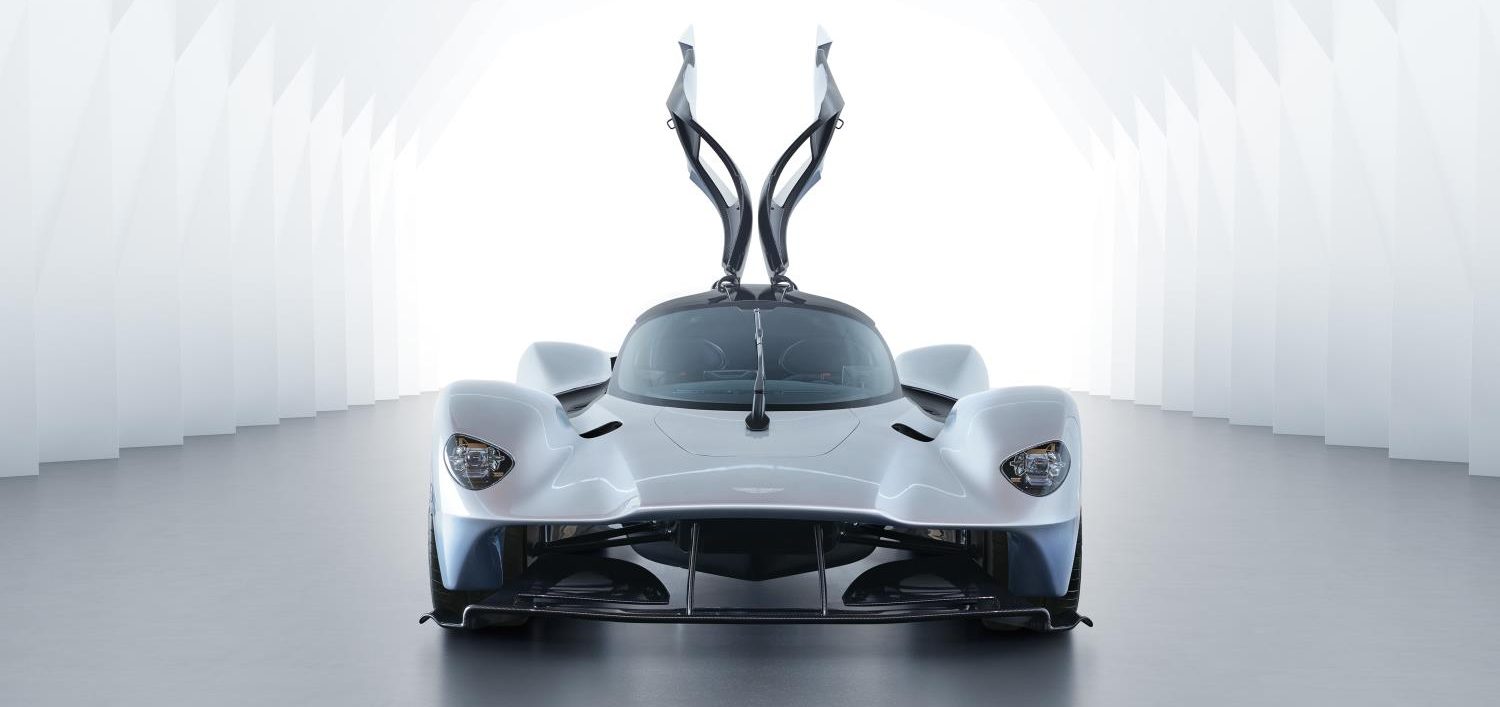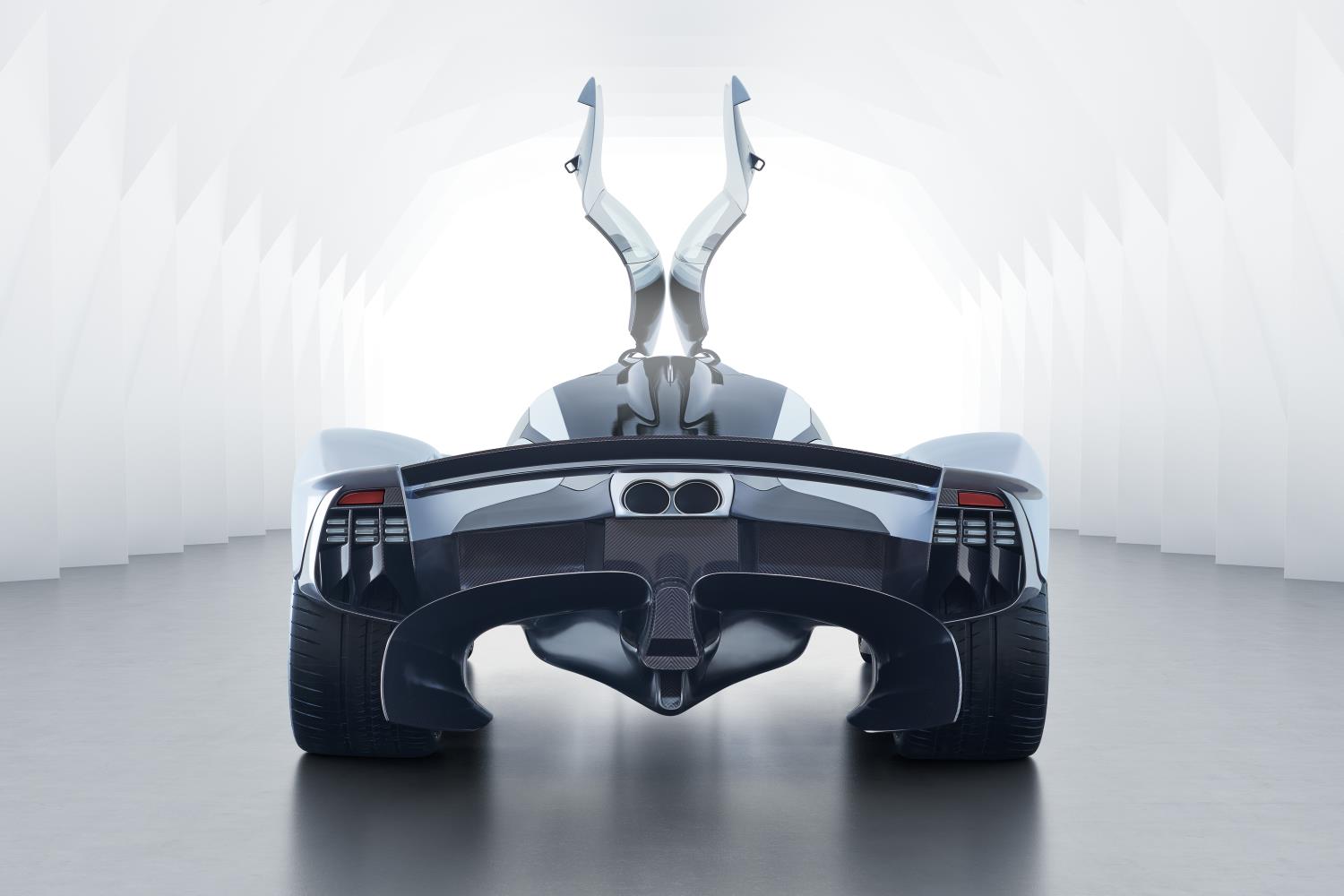
EXTERIOR AND INTERIOR
- Aerodynamic development has driven evolution of hypercar’s exterior design
- Exquisite, innovative detailing reflect the uncompromising pursuit of performance
- Ultra-efficient interior packaging achieves space for two 98 percentile adults
- Cockpit features F1-style reclined driving position and minimalist ergonomics
12 July 2017, Gaydon: Since the first reveal of the Aston Martin Valkyrie hypercar in July 2016, Aston Martin, Red Bull Advanced Technologies and project partner AF Racing have been working intensively to further develop the Valkyrie’s aerodynamics, body styling and cockpit packaging.
The teardrop-shaped cockpit’s upper body surfaces and lower tub contours follow the envelope of space available between the huge full length Venturi tunnels that run either side of the cockpit floor. Drawing huge quantities of air beneath the car to feed the rear diffuser, these tunnels are the key to generating the Aston Martin Valkyrie’s extraordinary levels of downforce while keeping the upper body surfaces free from additional aerodynamic devices that would spoil the purity of the styling.
To maximise interior space the seats are mounted directly to the tub, with occupants adopting a reclined ‘feet-up’ position reminiscent of today’s Formula One and Le Mans Prototype race cars, ensuring driver and passenger are extremely safe, perfectly supported and feel completely at one with the car. A four-point harness comes as standard, while an optional six-point harness will be offered for those who intend to do more track driving.
The Aston Martin Design team were keen to keep distractions to a minimum and focus the driver on the road ahead. To this end all switchgear is located on the steering wheel, with all the vital signs shown on a single OLED display screen. The steering wheel is also detachable, both to aid ingress and egress, and to serve as an additional security device.
Great attention has been taken with the glasshouse design to ensure forward and peripheral side-to-side vision is virtually uninterrupted. To avoid any unwanted aerodynamic disturbance or stylistic ‘clutter’ traditional door mirrors have been replaced by discreetly mounted rear facing cameras in each of the Aston Martin Valkyrie’s flanks. These feed two displays which are positioned at the base of each A-post to mimic the view provided by conventional door mirrors. The all-enveloping bodywork and roof-mounted engine air intake means there is no rear window, negating the requirement for a rearview mirror.
Matt Hill, Aston Martin Creative Director of Interiors said of the Aston Martin Valkyrie’s cockpit design: “It’s been a tremendous challenge to make the interior packaging work. We’ve embraced Red Bull Racing’s Formula One ethos and approached from a different angle than conventional road car design. In this instance, we’ve started from a position where you think something is impossible and work at it until you find a way to make it work. We’ve been fighting for millimetres everywhere, but the battle has been worth it, as it’s been fantastic seeing customers try the interior buck for size. They love the ritual of getting in and how it feels to be sat behind the wheel. They’re also genuinely surprised at how the car just seems to swallow them. You really do have to sit in it to believe there is genuine space for two large adults.”
While the essence of the original Aston Martin Valkyrie exterior design remains unchanged, Adrian Newey’s pursuit of downforce and aerodynamic efficiency has driven many detail changes to the bodywork. These requirements have been faithfully incorporated into the design by the Aston Martin Design Team in a genuine case of form following function.
One of the biggest changes in this latest model are openings in the body surface between the cockpit and front wheel arches, Adrian Newey having found that they were the key to achieving considerable gains in front downforce. It was then the job of the Aston Martin Design Team to integrate these new apertures into the overall design and ensure they had aesthetic merit as well as aerodynamic function.
While aerodynamics and downforce are the dominant story, Aston Martin Valkyrie features some delightful details. Some of the most striking are the headlights, which take inspiration from the pure functionality of a Formula One car’s components. Aston Martin’s designers stripped things back to the bare essentials, celebrating the engineering rather than concealing it behind cladding. With the low and high beam elements attached to an intricate exposed anodised aluminium frame not only are the headlamp units a work of art, but they are 30-40 per cent lighter than the lightest series production headlamps available to Aston Martin.
The same approach has been taken with the Aston Martin ‘wings’ badge that adorns the nose. With the regular badge considered too heavy, and a simple sticker not befitting for a car of the Aston Martin Valkyrie’s quality and cutting-edge nature, the Aston Martin Design Team came up with a chemical etched aluminium badge just 70 microns thick. That’s 30 per cent thinner than a human hair, and a remarkable 99.4 per cent lighter than the regular enamel wings badge. The badge (nicknamed the ‘lacewing’) is then attached to the painted body and covered with a perfectly smooth coat of lacquer.
Further detail innovation can be found at the rear of the car, with the centre high mounted stop light (CHMSL). Mounted on the tip of the small shark’s fin that runs down the spine of the Aston Martin Valkyrie’s airbox and rear bodywork, the light is just 5.5mm wide and 9.5mm high. Illuminated by a red LED it is the world’s smallest CHMSL and evidence of how every element of the Aston Martin Valkyrie is scrutinised in the pursuit of eliminating unnecessary weight and drag.
Aston Martin Creative Director of Exterior Design, Miles Nurnberger, said of the Aston martin Valkyrie’s design evolution: “I would say we’re around 95 per cent of the way there with the exterior design. Much of what you see is actually the structure of the car, so this had to be signed-off relatively early in the project. The remaining areas of non-structural bodywork are still subject to evolution and change as Adrian [Newey] continues to explore way of finding more downforce. The new outlets in the body are a case in point. Ordinarily the last thing we’d want to do to one of our surfaces is cut a hole in it, but these vents work the front wings so much harder that they’ve found a significant gain in front downforce. The fact that they are so effective gives them their own functional beauty, but we’ve finessed them without impacting on their functionality. That they also serve as windows through which to view the fabulous wing section front wishbones is a welcome bonus!”
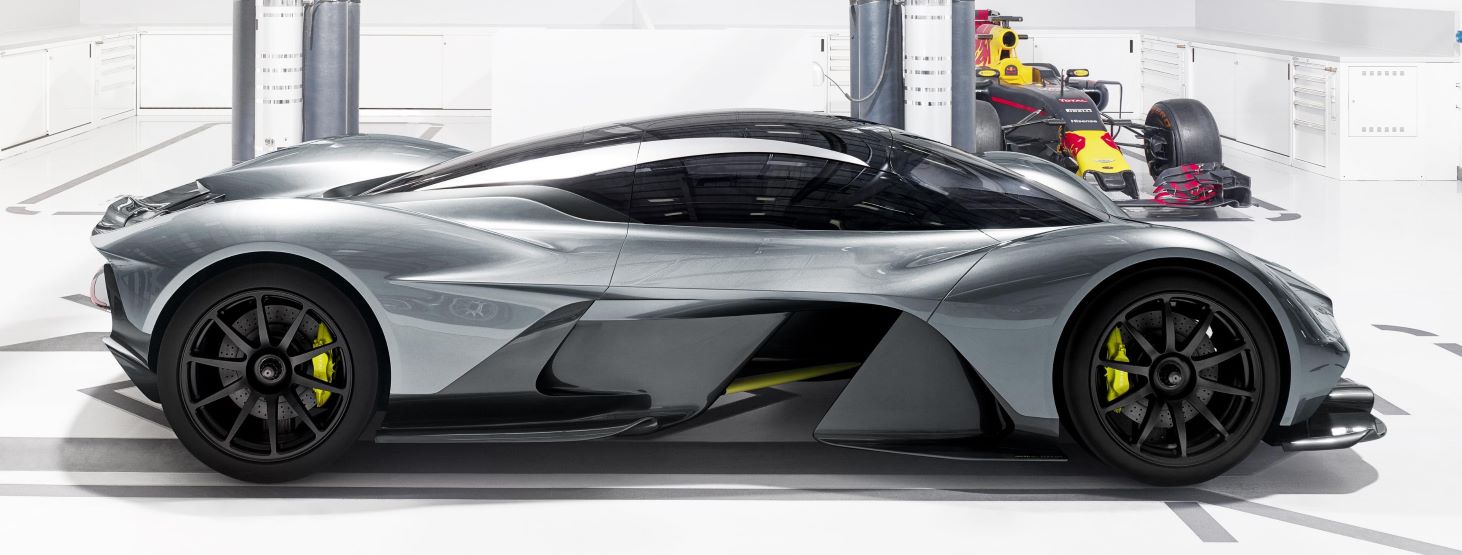
specifications:
Engine and Performance
- Engine: 6.5-liter naturally aspirated V12 developed by Cosworth
- Power Output: 1,160 horsepower
- Torque: 900 Nm (664 lb-ft)
- Hybrid System: Integrated Electric Motor (KERS)
- Total Power Output: 1,160 horsepower (1,145 bhp) and 900 Nm of torque
- Redline: 11,100 rpm
Transmission
- Gearbox: 7-speed automatic (single-clutch)
Dimensions and Weight
- Length: Approximately 4,675 mm (184.1 inches)
- Width: 1,900 mm (74.8 inches)
- Height: 1,000 mm (39.4 inches)
- Weight: Approximately 1,030 kg (2,271 lbs)
Performance
- Top Speed: Over 220 mph (354 km/h)
- 0-60 mph: Approximately 2.5 seconds
Chassis and Aerodynamics
- Chassis: Carbon fiber monocoque
- Suspension: Inboard pushrod-operated torsion bar and damper system (front and rear)
- Aerodynamics: Active aerodynamics with extreme downforce capabilities
Interior
- Seating: 2 seats
- Steering Wheel: Removable steering wheel with an OLED display
- Instrument Panel: Digital displays for instrumentation
Production and Availability
- Production Limit: 150 units for the road version, plus 25 track-only versions (Valkyrie AMR Pro)
- Price: Estimated at around $3 million

ASTON MARTIN VALKYRIE AM-RB 001 HYPERCAR
- Continuation of a naming tradition stretching back seven decades
- Joins famous lineage of Aston Martin ‘V’ cars
- Valkyrie name taken from ancient Norse mythology
6 March 2017, Gaydon: The revolutionary hypercar being co-developed by Aston Martin and Red Bull Advanced Technologies, formerly identified by its codename AM-RB 001, has now been officially named the Aston Martin Valkyrie.
The name continues a fine tradition of Aston Martin ‘V’ cars. This began back in 1951 with Vantage, which was selected as a name to distinguish high performance variants of the then current model, the DB2. Boasting 125bhp versus 105bhp for the standard engine, the Vantage represented a significant increase in performance and desirability. The first time the Vantage badge appeared was on the side of the DB5.
It remained a name reserved for the most potent model derivatives until 2005, when the Vantage became a model line in its own right. Twelve years later the acclaimed family of V8 and V12-powered models has made the Vantage the most successful model in Aston Martin’s history.
Virage, Vanquish and the Aston Martin Vulcan – Aston Martin’s very own God of fire – are more recent ‘V’ cars to continue this lineage. Now, seven decades after the Vantage name started it all, the Aston Martin Valkyrie propels this uniquely distinctive and lyrical family of model names to another level.
For Aston Martin’s Chief Creative Officer, Marek Reichman, Valkyrie perfectly captures the drama of what is not only the ultimate Aston Martin, but the ultimate expression of hypercar design, engineering and performance: “Aston Martin model names have deep meaning. They need to inspire and excite. To tell a story and enrich a narrative that stretches back some 104-years. The Aston Martin Valkyrie is an incredibly special car that demands an equally remarkable name; an uncompromising car that leaves nothing in reserve. The connotations of power and honour, of being chosen by the Gods are so evocative, and so pertinent to a car that only a fortunate few will ever experience.”
While its name is rooted in ancient mythology, the Aston Martin Valkyrie is a pure expression of modern technology. By bringing together Aston Martin, Red Bull Advanced Technologies, project partner AF Racing and some of the world’s leading technology partners, the Aston Martin Valkyrie promises otherworldly performance befitting of its name.

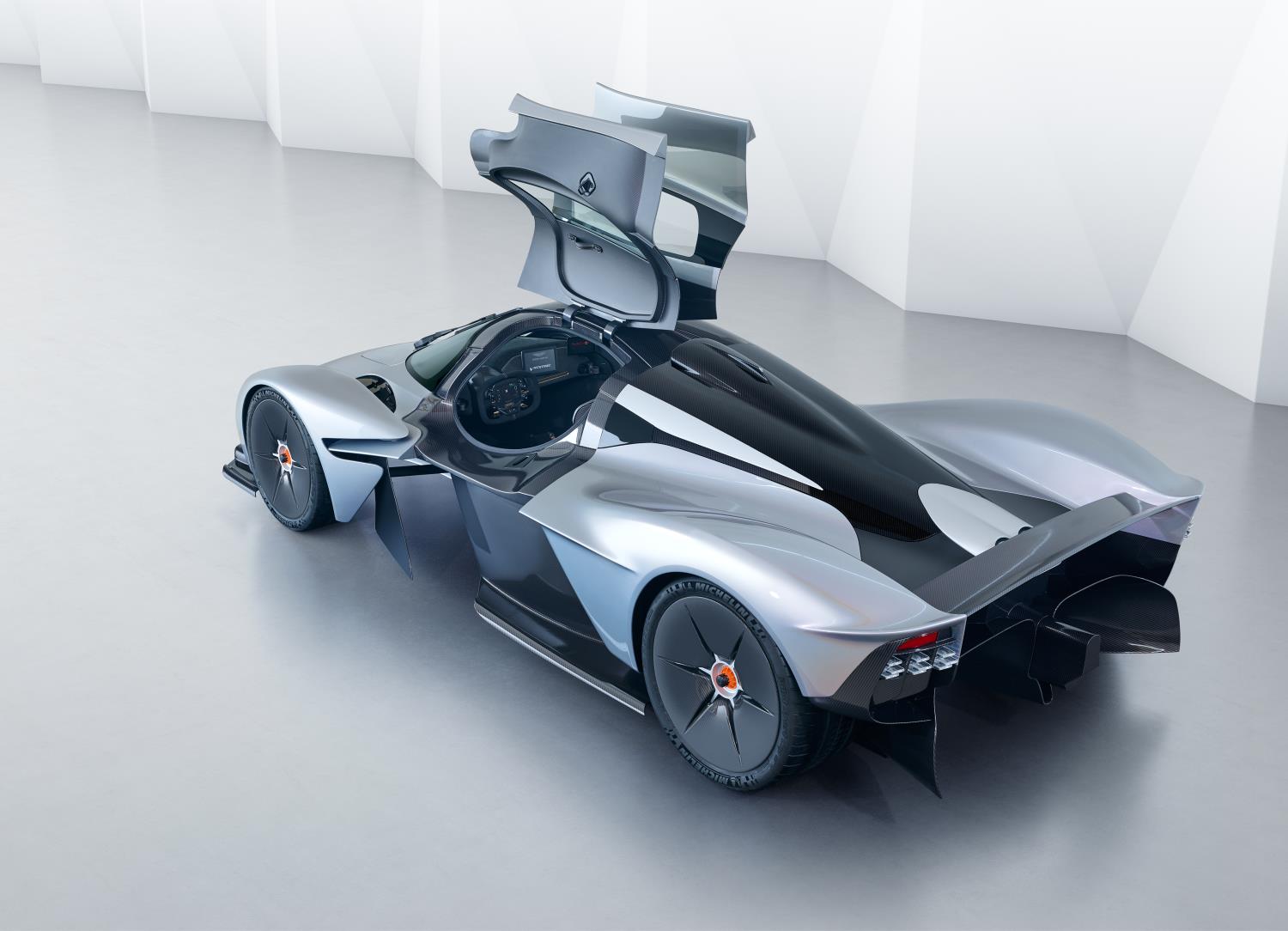
MICHELIN ANNOUNCED AS TYRE PARTNER FOR ASTON MARTIN VALKYRIE
- Michelin joins Aston Martin’s world-class roster of technical partners for hypercar
- Ultimate road-going hypercar demands the ultimate high-performance road tyres
- Aston Martin Valkyrie to be supplied with Michelin’s renowned Pilot Sport Cup 2 tyres
07 March 2017, Gaydon: Tyre manufacturer Michelin has been confirmed as the latest technical partner to join the Aston Martin Valkyrie hypercar programme. Founded in 1889, Michelin – one of the largest tyre companies in the world – has been at the forefront of tyre development for almost 130 years.
A world renowned brand with an enviable reputation, Michelin has vast experience in both the road car and competition car arenas. Winning success in Formula One, the World Endurance Championship, World Rally Championship and MotoGP has seen Michelin engineers push the limits of tyre design: experience that has driven the development of Michelin’s high-performance road tyres and helped forge a tremendous reputation amongst the world’s supercar owners.
With its high-power, high-downforce, low-weight philosophy the Aston Martin Valkyrie promises to redefine the limits of road car performance. With many owners certain to explore these limits on a race track, the Aston Martin Valkyrie will put unprecedented demands on its tyres. Though still in the early stages of development, Aston Martin and Red Bull Advanced Technologies can confirm the hypercar will run on Michelin’s Pilot Sport Cup 2 tyres: 265/35 ZR20 at the front; 325/30 ZR21 at the rear. They will be mounted to lightweight magnesium alloy wheels (20 x 9.5J front, 21 x 11.5J rear) featuring race-specification centre-lock nuts to further reduce unsprung mass.
Michelin join a world-class collective including engine builders Cosworth, transmission experts Ricardo, carbon fibre structure specialists Mutimatic, leaders in hybrid battery technology Rimac, brake system suppliers Alcon and Surface Transforms, electronics giant Bosch and lighting experts Wipac.

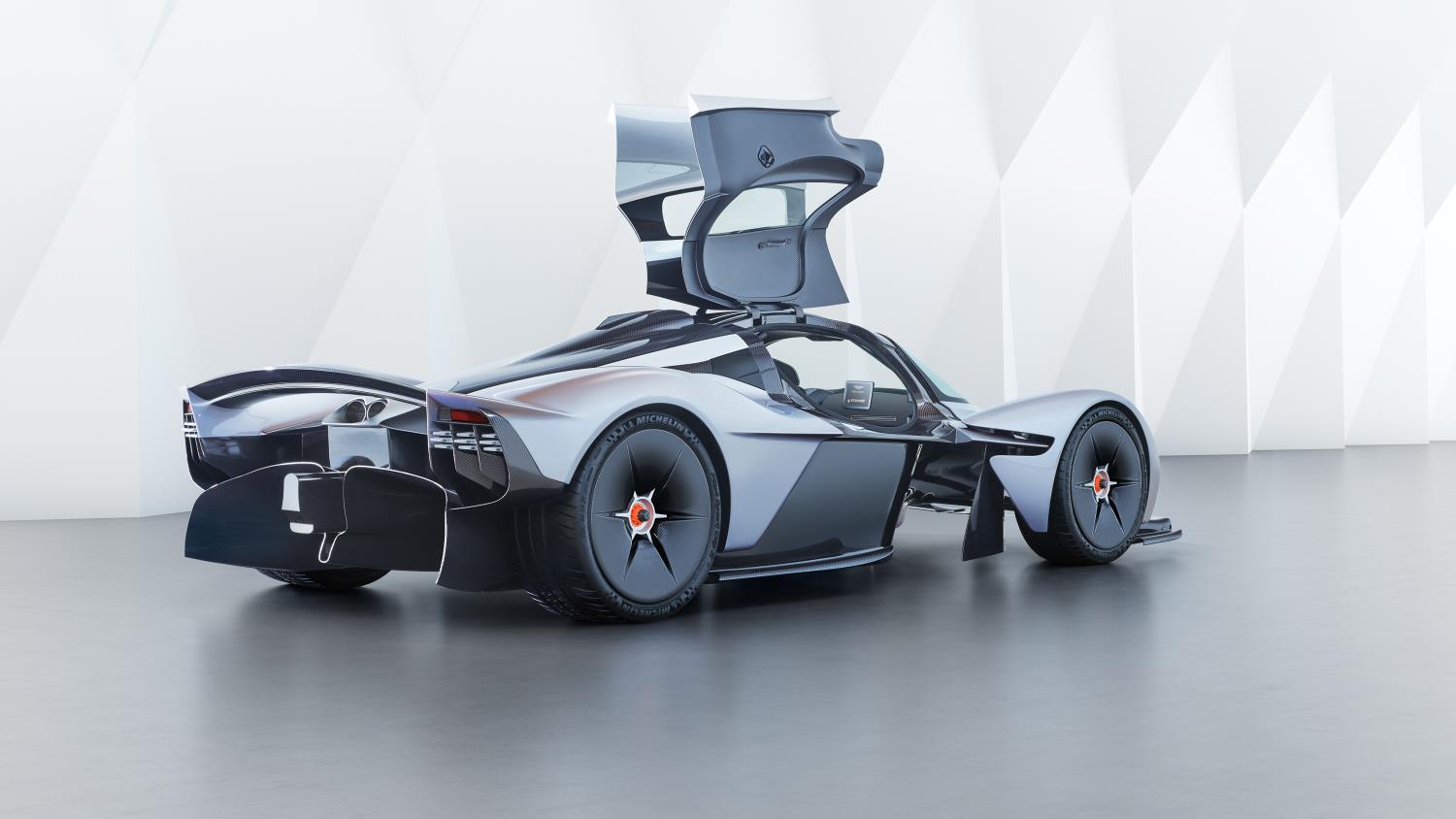

ASTON MARTIN ANNOUNCES AM-RB 001 TECHNICAL PARTNERS
- Prestigious roll call of world-leading technical partners working alongside Aston Martin and Red Bull Advanced Technologies
- Bespoke 6.5-litre naturally aspirated V12 engine designed and built by Cosworth
- Cutting-edge 7-speed transmission developed by Ricardo Engineering
- Carbon fibre MonoCell supplied by long-time composites partner, Multimatic
15 February 2017, Gaydon: With design and engineering work on the AM-RB 001 hypercar progressing apace, Aston Martin, Red Bull Advanced Technologies and project partner AF Racing today confirm some of the key technical partners for AM-RB 001.
Working to the exacting brief of both brands, the technical partners have been selected for their unrivalled expertise and willingness to push the performance boundaries. Together with Adrian Newey, Red Bull Racing’s Chief Technical Officer and Aston Martin’s VP and Chief Special Operations Officer, David King and his team, they will embrace the challenges inherent with delivering a car poised to redefine the limits of road car performance.
The heart of every Aston Martin is its engine. Never more so than in the AM-RB 001, which is why it has been entrusted to legendary engine builder, Cosworth. An illustrious name with an impeccable motorsport pedigree, the UK-based company will bring all its Formula One and high performance production engine experience to bear in the design and manufacture of the AM-RB 001’s bespoke, high-revving 6.5-litre naturally aspirated V12 engine.
Mated to AM-RB 001’s all-new engine is a bespoke 7-speed paddle-shift transmission. Designed and manufactured by Ricardo, to Red Bull Advanced Technologies’ specification, the gearbox will be the perfect partner to Cosworth’s V12. Conforming to the radical hypercar’s ethos of minimal mass and maximum efficiency and led by Red Bull Advanced Technologies’ simulation work, Ricardo will deploy intelligent engineering solutions to achieve Newey’s uncompromising goals.
Not content with commissioning the ultimate road-legal internal combustion engine, the AM-RB 001 also boasts a lightweight hybrid battery system supplied by Rimac. Acknowledged as world-leaders in high-performance battery technology, the Croatian-based company has showcased its capabilities with the innovative Concept-One: the world’s first – and fastest – all-electric hypercar.
With lightweight construction paramount the AM-RB 001’s MonoCell is constructed from carbon fibre by world-leading composite experts, Multimatic. A long-standing technology partner on projects such as One-77 and Aston Martin Vulcan, Multimatic will combine its unrivalled manufacturing experience with Red Bull Advanced Technologies’ knowledge gained from the design and build of ultra-competitive, championship-winning Formula One cars.
With a power-to-weight ratio of 1:1 – that’s to say one bhp for every kilogram of kerbweight – the AM-RB 001 requires a braking system that’s more than the equal of its powertrain. Step forward Alcon and Surface Transforms, who together are responsible for supplying the lightweight, high performance brake calipers and carbon discs required to deliver the stopping power.
To guarantee maximum efficiency, performance and dynamic control, electronics expert Bosch has been entrusted with developing bespoke Engine Control Unit (ECU), Traction Control Unit (TCU) and Electronic Stability Programme (ESP) systems for the AM-RB 001, while UK light manufacturer, Wipac, is responsible for the hypercar’s full LED headlamps and tail lamps.
Adrian Newey, Red Bull Racing’s Chief Technical Officer, says of the technical partners supporting the AM-RB 001 project: “Much like Formula One, designing, engineering and building a car like the AM-RB 001 is a massive team effort. To achieve great things you need to surround yourself with the best people. Experience, creativity, energy, diligence and perfectionism are absolute must-have qualities in every area of the project. Having great technical partners such as those working with us is both reassuring and motivating. Together we aim to produce an innovative piece of engineering art.
David King, VP and Chief Special Operations Officer, commented: “Making the AM-RB 001 presents huge challenges. It’s a real test of everyone involved, but that’s as it should be, for we’re genuinely raising the bar with this car. That’s what makes the project so special, and why having the right technical partners is so critical. Some of those names we’re working with are long-standing suppliers of Aston Martin, but there are some new names in there, too. Whether forging fresh partnerships or building on existing relationships, the AM-RB 001 project is a shared engineering adventure we’re all relishing.”
A maximum of 150 road going AM-RB 001s will be built, including all remaining prototypes, with 25 additional track-only versions. First deliveries are due to commence in 2019.
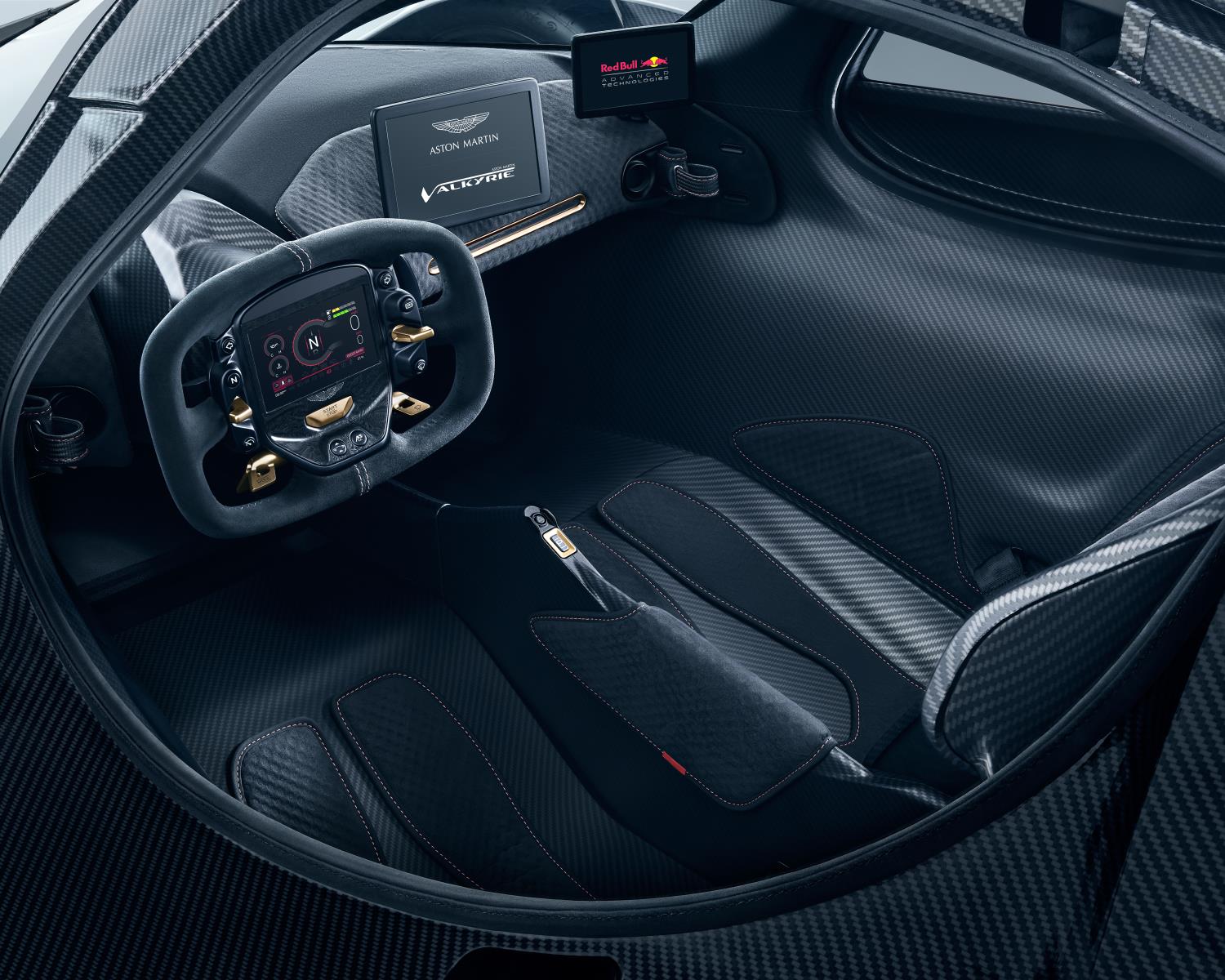

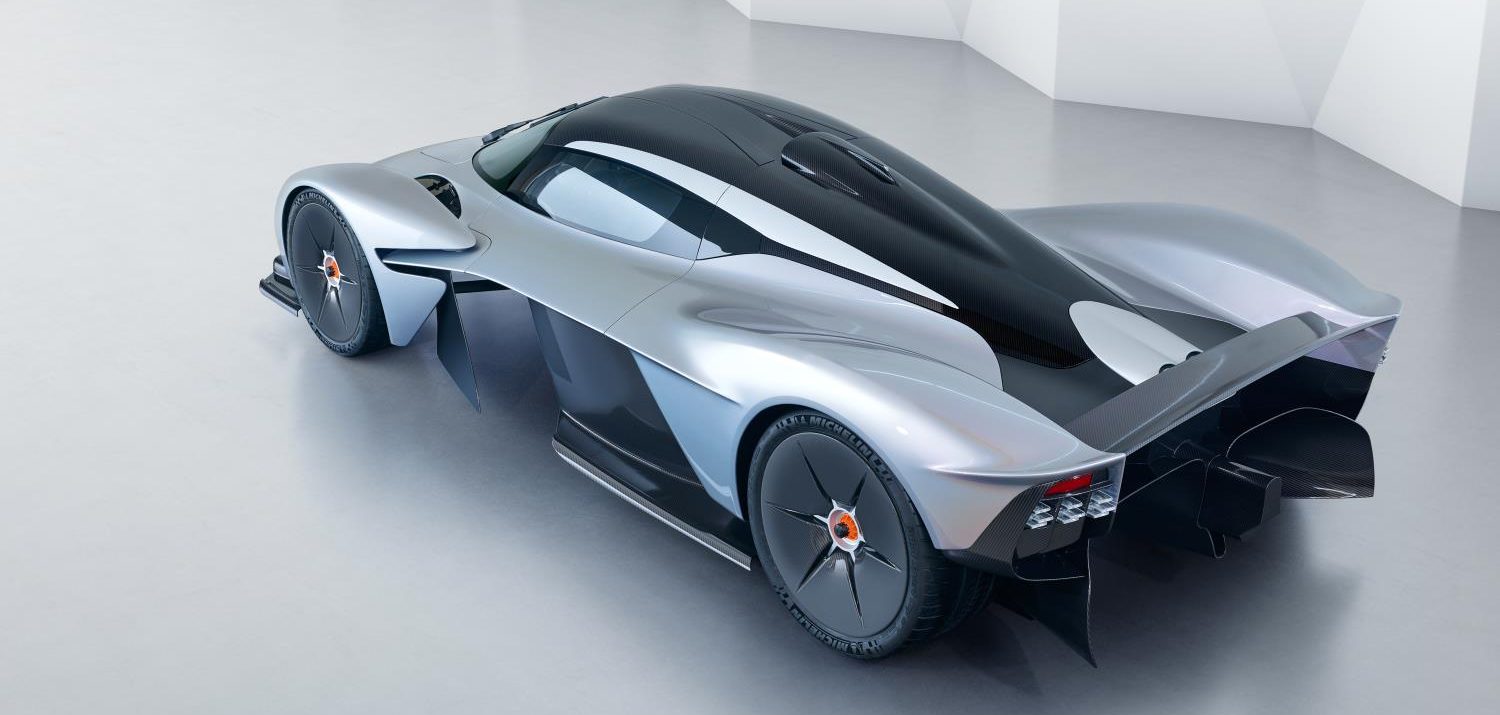

ASTON MARTIN VULCAN SPECIAL DELIVERY
- First customers experience the exhilaration of their own Aston Martin Vulcan after receiving world-class driving tuition
- Three year driver experience programme starts at Abu Dhabi Formula 1 circuit
15 February, 2016, Yas Marina, Abu Dhabi: The first owners of the Aston Martin Vulcan travelled to Abu Dhabi last week to receive world-class tuition from an elite team of racing drivers, led by Aston Martin Racing works’ driver Darren Turner.
The Aston Martin Vulcan is the product of the luxury British carmaker’s extensive motorsport experience. There is no question that the track-only supercar demonstrates Aston Martin’s flair for design and now a select group of owners have had the opportunity to use the Aston Martin Vulcan for its intended purpose – as an exhilarating 820 bhp supercar, engineered exclusively for extreme performance on-track.
The customers in Abu Dhabi received tuition in the V12 Vantage S road car and the Vantage GT4 race car, before heading out onto the iconic Formula 1 circuit in their own Aston Martin Vulcan, powered by a potent 7.0-litre V12 engine. Passenger-side tuition was given on every lap and the customer’s skills were tested throughout the day and into the night so they could fully experience the car in different atmospheric conditions.
Aston Martin Director of Special Projects and Motorsport David King commented: “Aston Martin Vulcan is a very special car and that is why we have developed a unique ownership programme. This includes specialist training so customers can drive it in the way it was intended. It has been great to see the first customer’s reactions after unleashing their very own Aston Martin Vulcan on the Grand Prix circuit here in Abu Dhabi.”
Just 24 Aston Martin Vulcans will be built in total and all 24 customers will receive world-class tuition so they are able to make the most of their new supercar.
Aston Martin Racing works’ driver and high performance development driver Darren Turner said: “The priority for all of us on the team was to produce a car that provides immense enjoyment for the customers. Judging by the reactions we have seen this week that goal has been achieved and surpassed.
The guys here this week have all been in the car as my passenger at recent events, but this was the first time they got to see and drive their very own Aston Martin Vulcan. It has been a pleasure to see how quickly they have all got up to speed and to hear their first impressions of the car. I predict many fun track days ahead for these guys!”
